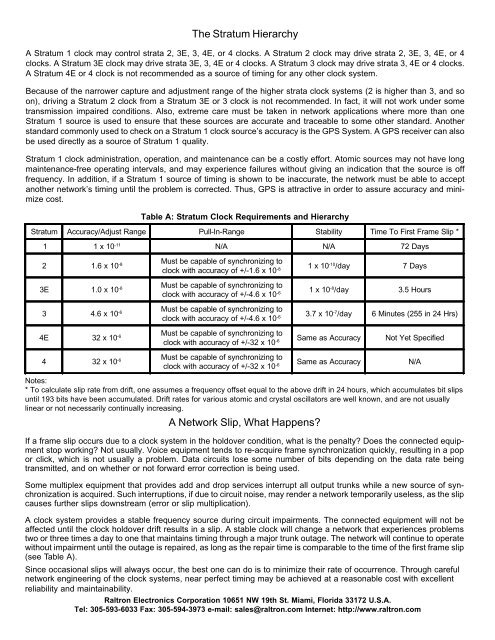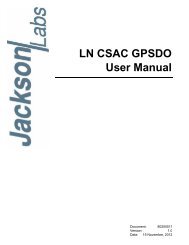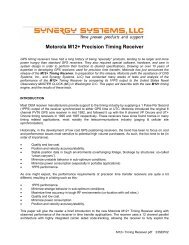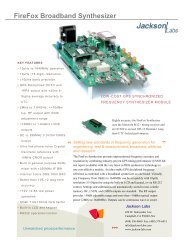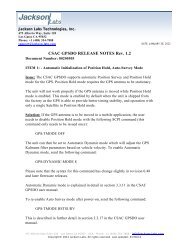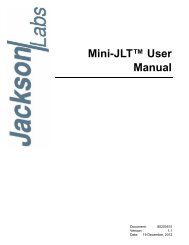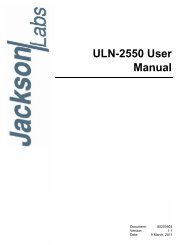Stratum Levels Defined - Jackson Labs Technologies, Inc.
Stratum Levels Defined - Jackson Labs Technologies, Inc.
Stratum Levels Defined - Jackson Labs Technologies, Inc.
You also want an ePaper? Increase the reach of your titles
YUMPU automatically turns print PDFs into web optimized ePapers that Google loves.
The <strong>Stratum</strong> Hierarchy<br />
A <strong>Stratum</strong> 1 clock may control strata 2, 3E, 3, 4E, or 4 clocks. A <strong>Stratum</strong> 2 clock may drive strata 2, 3E, 3, 4E, or 4<br />
clocks. A <strong>Stratum</strong> 3E clock may drive strata 3E, 3, 4E or 4 clocks. A <strong>Stratum</strong> 3 clock may drive strata 3, 4E or 4 clocks.<br />
A <strong>Stratum</strong> 4E or 4 clock is not recommended as a source of timing for any other clock system.<br />
Because of the narrower capture and adjustment range of the higher strata clock systems (2 is higher than 3, and so<br />
on), driving a <strong>Stratum</strong> 2 clock from a <strong>Stratum</strong> 3E or 3 clock is not recommended. In fact, it will not work under some<br />
transmission impaired conditions. Also, extreme care must be taken in network applications where more than one<br />
<strong>Stratum</strong> 1 source is used to ensure that these sources are accurate and traceable to some other standard. Another<br />
standard commonly used to check on a <strong>Stratum</strong> 1 clock source’s accuracy is the GPS System. A GPS receiver can also<br />
be used directly as a source of <strong>Stratum</strong> 1 quality.<br />
<strong>Stratum</strong> 1 clock administration, operation, and maintenance can be a costly effort. Atomic sources may not have long<br />
maintenance-free operating intervals, and may experience failures without giving an indication that the source is off<br />
frequency. In addition, if a <strong>Stratum</strong> 1 source of timing is shown to be inaccurate, the network must be able to accept<br />
another network’s timing until the problem is corrected. Thus, GPS is attractive in order to assure accuracy and minimize<br />
cost.<br />
Table A: <strong>Stratum</strong> Clock Requirements and Hierarchy<br />
<strong>Stratum</strong> Accuracy/Adjust Range Pull-In-Range Stability Time To First Frame Slip *<br />
1 1 x 10 -11 N/A N/A 72 Days<br />
2 1.6 x 10 -8 Must be capable of synchronizing to<br />
clock with accuracy of +/-1.6 x 10 -8 1 x 10 -10 /day 7 Days<br />
3E 1.0 x 10 -6 Must be capable of synchronizing to<br />
clock with accuracy of +/-4.6 x 10 -6 1 x 10 -8 /day 3.5 Hours<br />
3 4.6 x 10 -6 Must be capable of synchronizing to<br />
clock with accuracy of +/-4.6 x 10 -6 3.7 x 10 -7 /day 6 Minutes (255 in 24 Hrs)<br />
4E 32 x 10 -6 Must be capable of synchronizing to<br />
clock with accuracy of +/-32 x 10 -6 Same as Accuracy Not Yet Specified<br />
4 32 x 10 -6 Must be capable of synchronizing to<br />
clock with accuracy of +/-32 x 10 -6 Same as Accuracy N/A<br />
Notes:<br />
* To calculate slip rate from drift, one assumes a frequency offset equal to the above drift in 24 hours, which accumulates bit slips<br />
until 193 bits have been accumulated. Drift rates for various atomic and crystal oscillators are well known, and are not usually<br />
linear or not necessarily continually increasing.<br />
A Network Slip, What Happens<br />
If a frame slip occurs due to a clock system in the holdover condition, what is the penalty Does the connected equipment<br />
stop working Not usually. Voice equipment tends to re-acquire frame synchronization quickly, resulting in a pop<br />
or click, which is not usually a problem. Data circuits lose some number of bits depending on the data rate being<br />
transmitted, and on whether or not forward error correction is being used.<br />
Some multiplex equipment that provides add and drop services interrupt all output trunks while a new source of synchronization<br />
is acquired. Such interruptions, if due to circuit noise, may render a network temporarily useless, as the slip<br />
causes further slips downstream (error or slip multiplication).<br />
A clock system provides a stable frequency source during circuit impairments. The connected equipment will not be<br />
affected until the clock holdover drift results in a slip. A stable clock will change a network that experiences problems<br />
two or three times a day to one that maintains timing through a major trunk outage. The network will continue to operate<br />
without impairment until the outage is repaired, as long as the repair time is comparable to the time of the first frame slip<br />
(see Table A).<br />
Since occasional slips will always occur, the best one can do is to minimize their rate of occurrence. Through careful<br />
network engineering of the clock systems, near perfect timing may be achieved at a reasonable cost with excellent<br />
reliability and maintainability.<br />
Raltron Electronics Corporation 10651 NW 19th St. Miami, Florida 33172 U.S.A.<br />
Tel: 305-593-6033 Fax: 305-594-3973 e-mail: sales@raltron.com Internet: http://www.raltron.com


